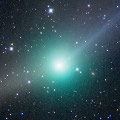
|
Now it is 7.0 mag (Mar. 30, Salvador Aguirre). It keeps bright as 7 mag and observable in excellent condition until April. Then it will be fading and will be unobservable in June. In the Southern Hemisphere, it is observable in the evening low sky from April to June.
Date(TT) R.A. (2000) Decl. Delta r Elong. m1 Best Time(A, h)
Apr. 7 9 15.06 53 10.1 1.631 2.098 103 7.6 20:10 (180, 2)
Apr. 14 9 1.73 48 1.0 1.780 2.158 97 8.0 19:29 (180, 7)
|
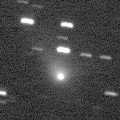
|
It brightened up to 9 mag in January and February in the evening low sky. In the Southern Hemisphere, it is observable in the evening extremely low sky in April and May. It will never be observable again in the Northern Hemisphere.
Date(TT) R.A. (2000) Decl. Delta r Elong. m1 Best Time(A, h)
Apr. 7 2 53.69 1 15.5 2.080 1.283 27 12.3 19:10 ( 97, 8)
Apr. 14 3 18.96 1 44.6 2.137 1.339 28 12.7 19:01 ( 98, 9)
|

|
New Kreutz sungrazer comet discovered from the spacecraft images. Terry Lovejoy succeeded to catch the comet on the ground on Mar. 10 at 9.2 mag. The ephemeris says it is appearing in the evening sky. But actually, the comet must have evaporated at the perihelion passage on Mar. 15.
Date(TT) R.A. (2000) Decl. Delta r Elong. m1 Best Time(A, h)
Apr. 7 4 0.52 -3 36.8 1.227 0.882 45 12.9 19:10 (103, 24)
Apr. 14 4 34.88 -2 51.4 1.425 1.054 47 14.0 19:01 (107, 27)
|

|
Big asteroid discovered in 1906. It suddenly showed the cometary activity on Dec. 11, 2010, probably due to an impact of a small object. It was very bright as 11.5 mag visually (Dec. 17, 2010, Juan Jose Gonzalez). Now it is 14.1 mag (Jan. 3, Hidetaka Sato). It has already turned to be stellar.
Date(TT) R.A. (2000) Decl. Delta r Elong. m1 Best Time(A, h)
Apr. 7 17 0.39 -17 13.3 1.775 2.452 121 13.1 3:59 (180, 72)
Apr. 14 17 1.42 -17 41.9 1.700 2.450 128 13.0 3:32 (180, 73)
|
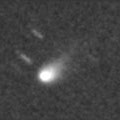
|
It is expected to be bright as 9 mag from 2012 to 2013. It is already so bright as 11.7 mag and visible visually (Mar. 22, Carlos Labordena). In the Northern Hemisphere, it keeps observable in good condition for a long time until 2012 autumn when the comet brightens up to 10 mag. In the Southern Hemisphere, it is hardly observble before the perihelion passage. But it becomes observable in good condition since 2013 after the perihelion passage.
Date(TT) R.A. (2000) Decl. Delta r Elong. m1 Best Time(A, h)
Apr. 7 15 31.76 55 43.9 3.232 3.702 110 13.2 2:30 (180, -1)
Apr. 14 15 24.97 56 19.2 3.171 3.639 110 13.1 1:56 (180, -1)
|
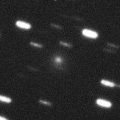
|
Now it is very bright at 12.5 mag (Apr. 1, Michael Jager). In the Northern Hemisphere, it locates extremely low in the morning until June. It will be observable at high location after summer. In the Southern Hemisphere, it will never be observable again.
Date(TT) R.A. (2000) Decl. Delta r Elong. m1 Best Time(A, h)
Apr. 7 0 30.36 29 9.4 2.629 1.759 23 13.3 4:53 (249,-23)
Apr. 14 0 50.88 31 25.6 2.694 1.822 23 13.5 4:58 (246,-22)
|

|
Now it is 12.2 mag (Mar. 25, Jakub Koukal). It is already low in the evening. It will be unobservable at the end of April.
Date(TT) R.A. (2000) Decl. Delta r Elong. m1 Best Time(A, h)
Apr. 7 3 50.89 16 31.8 2.763 2.125 41 13.3 19:10 (118, 9)
Apr. 14 4 6.71 17 12.9 2.831 2.144 38 13.4 19:01 (118, 8)
|
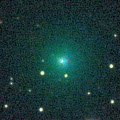
|
New comet discovered on Feb. 11. It was very bright as 10.6 mag (Feb. 12, A. Novichonok, V. Gerke). However, the comet got diffuse and faded rapidly after Feb. 20. It was still visible visually at 12.5 mag on Feb. 21 (Alan Hale). But it became completely invisible on Feb. 27 (Hidetaka Sato). The nuclear magnitude is fainter than 19 mag. It must have been disintegrated before the perihelion. It is not observable now.
Date(TT) R.A. (2000) Decl. Delta r Elong. m1 Best Time(A, h)
Apr. 7 0 39.06 12 51.0 1.911 0.933 8 13.5 4:53 (265,-16)
Apr. 14 0 34.06 12 14.0 1.948 1.005 14 14.0 4:58 (261, -8)
|
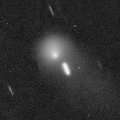
|
Now it is bright as 12.8 mag and visible visually (Mar. 14, John Drummond). It keeps bright as 13-14 mag for a long time after this until 2013. It is not observable in the Northern Hemisphere, but it is observable in good condition in the Southern Hemisphere.
Date(TT) R.A. (2000) Decl. Delta r Elong. m1 Best Time(A, h)
Apr. 7 3 6.76 -62 11.6 5.711 5.501 72 13.5 19:10 ( 35, 36)
Apr. 14 3 15.54 -60 50.3 5.713 5.508 73 13.5 19:01 ( 36, 35)
|
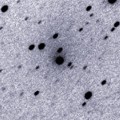
|
Now it is visible visually at 13.6 mag (Mar. 22, Carlos Labordena).
Date(TT) R.A. (2000) Decl. Delta r Elong. m1 Best Time(A, h)
Apr. 7 12 18.15 -12 16.2 5.278 6.259 167 13.6 23:13 (180, 67)
Apr. 14 12 15.26 -11 58.0 5.299 6.258 161 13.6 22:43 (180, 67)
|
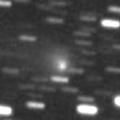
|
Now it is bright as 13.4 mag (Mar. 27, Jakub Cerny). It keeps 13-14 mag and observable in good condition until September.
Date(TT) R.A. (2000) Decl. Delta r Elong. m1 Best Time(A, h)
Apr. 7 17 57.32 -13 33.6 4.736 5.132 107 13.7 4:53 (182, 69)
Apr. 14 17 51.45 -13 27.1 4.612 5.131 115 13.6 4:22 (180, 68)
|
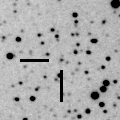
|
It brightened much faster than expected. It is so bright as 13.1 mag and visible visually (Mar. 26, Jakub Cerny). In the Northern Hemisphere, it keeps observable at 13-14 mag in good condition until early 2013. In the Southern Hemisphere, it is not observable until late 2012.
Date(TT) R.A. (2000) Decl. Delta r Elong. m1 Best Time(A, h)
Apr. 7 20 47.66 54 28.3 2.632 2.468 69 14.0 4:53 (204, -7)
Apr. 14 20 59.31 59 2.1 2.572 2.430 70 13.8 4:58 (199, -9)
|

|
Now it is 14.3 mag (Mar 13, Jakub Cerny). It is already unobservable in the Northern Hemisphere. In the Southern Hemisphere, it locates extremely low now. But it will be getting higher gradually after May. It is expected to be observable at 11-13 mag for a long time from 2012 summer to 2013 summer. It will be observable in excellent condition in the Southern Hemisphere. But it is not observable until 2013 January in the Northern Hemisphere.
Date(TT) R.A. (2000) Decl. Delta r Elong. m1 Best Time(A, h)
Apr. 7 1 40.21 -32 17.4 3.756 3.059 40 14.2 19:10 ( 59, 12)
Apr. 14 1 46.82 -32 38.8 3.670 3.004 42 14.1 19:01 ( 57, 10)
|

|
It brightened up to 17.1 mag in late June in 2011 (June 24, J. F. Hernandez). The condition of this apparition is bad, and it was not observable around the perihelion passage. It is appearing in the morning sky in the Southern Hemisphere, but it locates extremely low. It will not be observable until June in the Northern Hemisphere, when the comet will be 15.5 mag.
Date(TT) R.A. (2000) Decl. Delta r Elong. m1 Best Time(A, h)
Apr. 7 23 18.11 -11 49.0 2.660 1.891 32 14.2 4:53 (275, 14)
Apr. 14 23 33.17 -10 21.4 2.657 1.926 35 14.4 4:58 (271, 17)
|
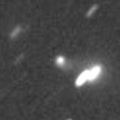
|
Although it has been unobservable for a while, now it is appearing in the morning sky. Now it is 14.3 mag (Mar. 27, Jakub Cerny). After this, it will be observable in good condition in the Southern Hemisphere while fading gradually. It will locate somewhat low in the Northern Hemisphere. In 2011, some visual observers reported it was very bright as 10-12 mag.
Date(TT) R.A. (2000) Decl. Delta r Elong. m1 Best Time(A, h)
Apr. 7 21 45.04 -14 4.7 3.127 2.658 53 14.3 4:53 (263, 35)
Apr. 14 21 56.27 -13 58.1 3.090 2.695 57 14.4 4:58 (259, 39)
|
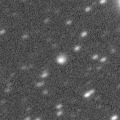
|
Now it is visible visually at 13.9 mag (Mar. 26, Jakub Cerny). It is expected to be 13 mag and will be observable in good condition in 2013. In the Northern Hemisphere, it will be getting higher gradually in the morning sky, and keeps observable for a long time. It is not observable in the Southern Hemisphere.
Date(TT) R.A. (2000) Decl. Delta r Elong. m1 Best Time(A, h)
Apr. 7 23 23.17 49 9.8 7.196 6.559 47 14.5 4:53 (224,-21)
Apr. 14 23 25.12 49 31.2 7.170 6.538 47 14.5 4:58 (221,-17)
|

|
It was expected to keep 14-15 mag for a long time from 2011 summer to 2012 summer. However, it is lost. It was observed only during two days in 2010 June. So the orbital elements are extremely uncertain. The condition is good in the Southern Hemisphere. But in the Northern Hemisphere, it is not observable until August.
Date(TT) R.A. (2000) Decl. Delta r Elong. m1 Best Time(A, h)
Apr. 7 3 19.10 -35 11.9 2.865 2.394 52 14.6 19:10 ( 67, 31)
Apr. 14 3 32.93 -32 2.3 2.923 2.417 50 14.7 19:01 ( 70, 29)
|

|
Now it is so bright as 12.3 mag and visible visually (Mar. 22, Carlos Labordena). Although it was extremely faint as 20.5 mag at the recovery in 2010 autumn, it brightened rapidly. It will keep 12-14 mag and observable in good condition for a long time from 2012 to 2013. But it locates somewhat low in the Northern Hemisphere in 2013.
Date(TT) R.A. (2000) Decl. Delta r Elong. m1 Best Time(A, h)
Apr. 7 13 16.95 14 22.2 2.313 3.266 158 14.8 0:16 (180, 41)
Apr. 14 13 11.88 14 35.6 2.310 3.250 155 14.7 23:39 (180, 40)
|
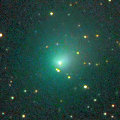
|
It reached up to 9.7 mag with a large bright coma in last autumn (Oct. 29, Juan Jose Gonzalez). Now it is fading. It has already faded down to 14.6 mag (Mar. 21, Jakub Cerny). It is already unobservable in the Northern Hemisphere. It will be unobservable in late April in the Southern Hemisphere.
Date(TT) R.A. (2000) Decl. Delta r Elong. m1 Best Time(A, h)
Apr. 7 3 27.49 -8 17.7 3.907 3.189 38 15.0 19:10 ( 94, 20)
Apr. 14 3 33.19 -8 39.7 4.010 3.247 35 15.2 19:01 ( 92, 17)
|
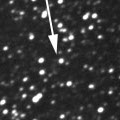
|
It is expected to be a great comet of 0 mag in 2013 spring. It is already bright and visible visually at 14.3 mag (Mar. 30, Alan Hale). Brightening as expected. In 2012, it keeps observable until summer while brightening gradually. It locates somewhat low in the Northern Hemisphere.
Date(TT) R.A. (2000) Decl. Delta r Elong. m1 Best Time(A, h)
Apr. 7 16 56.29 -24 50.9 4.446 5.046 121 15.3 3:55 (180, 80)
Apr. 14 16 53.01 -25 4.1 4.275 4.973 129 15.1 3:24 (180, 80)
|
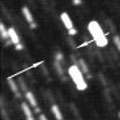
|
Now it is 16.0 mag (Mar. 26, Jakub Cerny). In the Southern Hemisphere, it will be observable at 15-16 mag in good condition for a long time until 2013 summer. It is not observable at all in the Northern Hemisphere.
Date(TT) R.A. (2000) Decl. Delta r Elong. m1 Best Time(A, h)
Apr. 7 20 8.46 -49 6.4 4.025 4.059 84 15.6 4:53 (310, 62)
Apr. 14 20 15.27 -50 49.8 3.912 4.043 90 15.5 4:58 (317, 65)
|
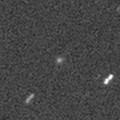
|
Now it is 17.2 mag (Mar. 15, Yasukazu Ikari). It will brighten up to 13.5 mag from summer to autumn. It keeps observable for a long time until December. In the Northern Hemisphere, it locates high until spring. But after that, it keeps locating low in the evening. In the Southern Henmisphere, it keeps locating low all through the time.
Date(TT) R.A. (2000) Decl. Delta r Elong. m1 Best Time(A, h)
Apr. 7 10 59.63 35 47.0 1.992 2.728 128 16.9 21:55 (180, 19)
Apr. 14 10 54.79 36 16.4 1.987 2.653 121 16.7 21:22 (180, 19)
|
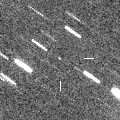
|
Now it is 17.6 mag (Mar. 13, Toshiyuki Takahashi). It brightened rapidly as expected. It will reach up to 16.5 mag from spring to summer. However, it locates extremely low in the Southern Hemisphere. In the Northern Hemisphere, it locates high now. But it will be getting lower gradually in the evening sky, and will be unobservable in June.
Date(TT) R.A. (2000) Decl. Delta r Elong. m1 Best Time(A, h)
Apr. 7 4 46.12 21 34.4 2.006 1.658 55 16.9 19:10 (131, 15)
Apr. 14 5 5.81 21 54.0 2.036 1.644 53 16.8 19:01 (131, 15)
|
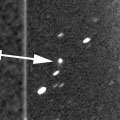
|
Now it is 16.7 mag (Mar. 21, Yasukazu Ikari). It is expected to keep 13 mag and observable in good condition in the Northern Hemisphere for a long time from 2013 to 2014. It keeps observable at 17-18 mag in good condition until June.
Date(TT) R.A. (2000) Decl. Delta r Elong. m1 Best Time(A, h)
Apr. 7 10 40.09 7 58.5 5.598 6.408 141 16.8 21:35 (180, 47)
Apr. 14 10 36.11 8 49.8 5.636 6.363 133 16.8 21:04 (180, 46)
|
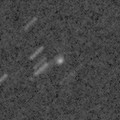
|
Now it is 16.7 mag (Mar. 19, Hiroshi Abe). In the Northern Hemisphere, it keeps observable at 16-17 mag in good condition for a long time from 2012 to 2013. It is not observable in the Southern Hemisphere.
Date(TT) R.A. (2000) Decl. Delta r Elong. m1 Best Time(A, h)
Apr. 7 10 19.29 66 0.4 3.705 4.022 101 16.9 21:14 (180,-11)
Apr. 14 10 0.23 66 6.8 3.772 3.993 95 16.9 20:27 (180,-11)
|
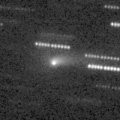
|
It reached up to 11-12 mag in 2011 autumn. Now it is fading. It has already faded down to 16.6 mag (Mar. 26, Jakub Cerny). It keeps observable in good condition until May when it becomes fainter than 18 mag. It locates somewhat low in the Southern Hemisphere.
Date(TT) R.A. (2000) Decl. Delta r Elong. m1 Best Time(A, h)
Apr. 7 11 51.59 31 3.7 1.405 2.253 138 16.9 22:46 (180, 24)
Apr. 14 11 48.43 30 37.9 1.496 2.301 133 17.1 22:16 (180, 24)
|
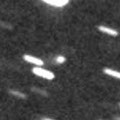
|
Now it is 17.0 mag (Mar. 14, Yasukazu Ikari). It keeps observable at 17 mag for a long time from 2011 to 2013. In 2012, it keeps observable in good condition until early September.
Date(TT) R.A. (2000) Decl. Delta r Elong. m1 Best Time(A, h)
Apr. 7 16 9.29 4 26.4 4.905 5.630 132 17.0 3:08 (180, 51)
Apr. 14 16 1.92 5 8.0 4.827 5.627 139 16.9 2:33 (180, 50)
|

|
It has not been observed since 2011 March. But it must be already bright as 17.5 mag. It will brighten up to 17 mag and will be observable in good condition from spring to summer.
Date(TT) R.A. (2000) Decl. Delta r Elong. m1 Best Time(A, h)
Apr. 7 18 56.89 -13 7.8 1.760 2.075 93 17.4 4:53 (216, 64)
Apr. 14 19 6.42 -12 14.2 1.697 2.083 97 17.3 4:58 (203, 66)
|

|
It brightened up to 13-14 mag and became visible visually from 2007 to 2009. Now it is fading. But it is still bright as 16.9 mag (Mar. 19, V. Gerke, S. Plaksa, A. Novichonok). In the Northern Hemisphere, it keeps observable in excellent condition until early summer in 2012. In the Southern Hemisphere, it locates extremely low only.
Date(TT) R.A. (2000) Decl. Delta r Elong. m1 Best Time(A, h)
Apr. 7 9 58.16 40 20.3 11.187 11.666 116 17.4 20:54 (180, 15)
Apr. 14 9 55.51 40 10.6 11.321 11.702 109 17.4 20:23 (180, 15)
|

|
Now it is 17.1 mag (Mar. 20, V. Gerke, S. Plaksa, A. Novichonok). It tends to brighten after the perihelion passage. It keeps observable at 17 mag from 2012 to 2013. It locates somewhat low in the Northern Hemisphere.
Date(TT) R.A. (2000) Decl. Delta r Elong. m1 Best Time(A, h)
Apr. 7 16 47.10 -15 6.2 2.476 3.157 124 17.5 3:45 (180, 70)
Apr. 14 16 47.26 -15 8.2 2.395 3.151 131 17.4 3:18 (180, 70)
|
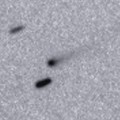
|
Now it is 16.6 mag (Mar. 20, M. Jaeger, E. Prosperi, S. Prosperi, W. Vollmann). It will brighten up to 13 mag in 2014. In 2012, it is observable at 17 mag in good condition in spring.
Date(TT) R.A. (2000) Decl. Delta r Elong. m1 Best Time(A, h)
Apr. 7 10 59.96 17 29.4 3.450 4.273 140 17.5 21:55 (180, 38)
Apr. 14 10 57.11 17 31.0 3.505 4.259 133 17.5 21:25 (180, 38)
|
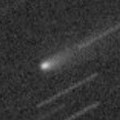
|
It is bright as 17.5 mag still now (Mar. 15, Jakub Cerny). It keeps the brightness after the small outburst in early December. It will keep 17-18 mag some more time. It is observable in good condition in the Southern Hemipshere. It keeps locating very low in the Northern Hemisphere.
Date(TT) R.A. (2000) Decl. Delta r Elong. m1 Best Time(A, h)
Apr. 7 15 0.69 -42 35.7 1.727 2.544 135 17.8 2:00 ( 0, 82)
Apr. 14 14 52.12 -42 12.0 1.751 2.619 142 17.9 1:24 ( 0, 83)
|
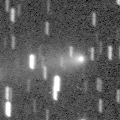
|
It had been fading after the perihelion passage in 2010 October, but it brightened again in outburst on Apr. 5, 2011. It reached up to 14.7 mag in May (May 28, Hidetaka Sato). It is bright as 17.2 mag still now, much brighter than expected (Mar. 19, V. Gerke, S. Plaksa, A. Novichonok). It locates low in the Southern Hemisphere. But in the Northern Hemisphere, it keeps observable in good condition after this. It will keep 18 mag for a while.
Date(TT) R.A. (2000) Decl. Delta r Elong. m1 Best Time(A, h)
Apr. 7 13 21.33 21 33.2 3.171 4.077 151 17.8 0:20 (180, 34)
Apr. 14 13 16.03 21 42.3 3.213 4.103 148 17.9 23:43 (180, 33)
|
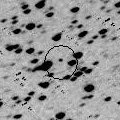
|
Peculiar asteroid moving along a cometary orbit. Now it is 17.4 mag (Jan. 4, Catalina Sky Survey). It keeps observable at 18 mag for a long time from 2008 to 2014.
Date(TT) R.A. (2000) Decl. Delta r Elong. m1 Best Time(A, h)
Apr. 7 7 1.49 21 23.0 6.711 6.731 86 17.9 19:10 (160, 31)
Apr. 14 7 1.67 21 50.9 6.840 6.739 80 17.9 19:01 (156, 29)
|
|
![]()
 (596) Scheila
(596) Scheila C/2011 F1 ( LINEAR )
C/2011 F1 ( LINEAR ) C/2011 Q2 ( McNaught )
C/2011 Q2 ( McNaught ) 78P/Gehrels 2
78P/Gehrels 2 C/2012 C2 ( Bruenjes )
C/2012 C2 ( Bruenjes ) C/2009 F4 ( McNaught )
C/2009 F4 ( McNaught ) 29P/Schwassmann-Wachmann 1
29P/Schwassmann-Wachmann 1 C/2006 S3 ( LONEOS )
C/2006 S3 ( LONEOS ) C/2011 UF305 ( LINEAR )
C/2011 UF305 ( LINEAR ) C/2011 R1 ( McNaught )
C/2011 R1 ( McNaught ) 71P/Clark
71P/Clark C/2011 A3 ( Gibbs )
C/2011 A3 ( Gibbs ) C/2010 S1 ( LINEAR )
C/2010 S1 ( LINEAR ) C/2010 M1 ( Gibbs )
C/2010 M1 ( Gibbs ) 246P/2010 V2 ( NEAT )
246P/2010 V2 ( NEAT ) C/2010 G2 ( Hill )
C/2010 G2 ( Hill ) C/2011 L4 ( PanSTARRS )
C/2011 L4 ( PanSTARRS ) C/2011 O1 ( LINEAR )
C/2011 O1 ( LINEAR ) C/2012 CH17 ( MOSS )
C/2012 CH17 ( MOSS ) 60P/Tsuchinshan 2
60P/Tsuchinshan 2 C/2011 J2 ( LINEAR )
C/2011 J2 ( LINEAR ) C/2012 A2 ( LINEAR )
C/2012 A2 ( LINEAR ) 49P/Arend-Rigaux
49P/Arend-Rigaux C/2010 R1 ( LINEAR )
C/2010 R1 ( LINEAR ) 105P/Singer Brewster
105P/Singer Brewster C/2005 L3 ( McNaught )
C/2005 L3 ( McNaught ) 152P/Helin-Lawrence
152P/Helin-Lawrence 117P/Helin-Roman-Alu 1
117P/Helin-Roman-Alu 1 C/2011 S2 ( Kowalski )
C/2011 S2 ( Kowalski ) 240P/2010 P1 ( NEAT )
240P/2010 P1 ( NEAT ) 2008 YB3
2008 YB3![]()





























